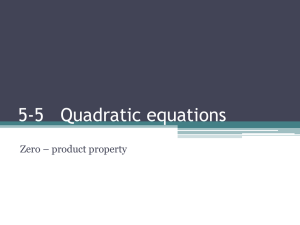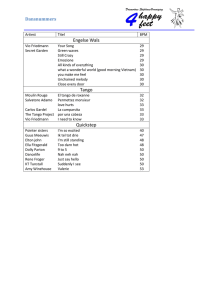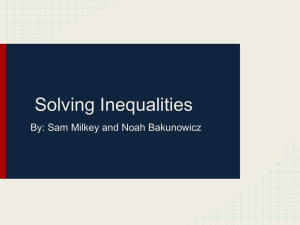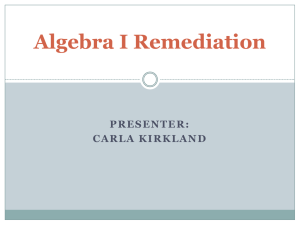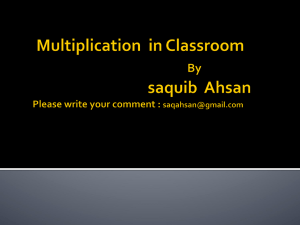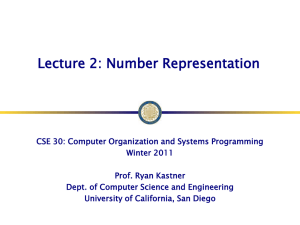Lecture 5 - Integers and Arithmetic4
advertisement
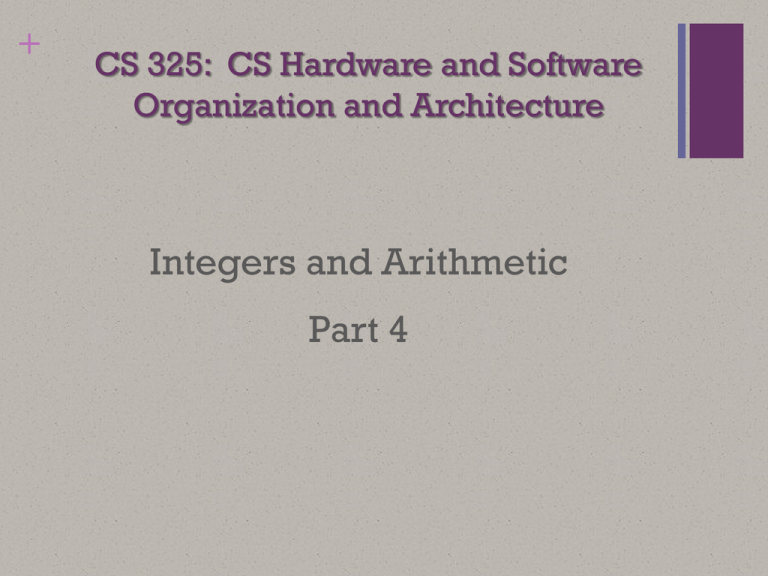
+ CS 325: CS Hardware and Software Organization and Architecture Integers and Arithmetic Part 4 + Outline Binary Multiplication Booth’s Algorithm Number Representations + 2’s Complement Binary Multiplication – Booth’s Algorithm Multiplication by bit shifting and addition. Removes the need for multiply circuit Requires: A way to compute 2’s Complement Available as fast hardware instructions X86 assembly instruction: NEG A way to compare two values for equality A B A How to do this quickly? 0 0 Exclusive Not OR (NXOR) Gate Compare all sequential bits of bit string A 0 1 and bit string B. Values are equal if the 1 0 comparison process produces all 1s. A way to shift bit strings. 1 1 Arithmetic bit shift, which preserves the sign bit when shifting to the right. 10110110 arithmetic shift right 11011011 x86 assembly instruction: SAR NXOR B 1 0 0 1 + 2’s Complement Binary Multiplication – Booth’s Algorithm Example: 5 x -3 First, convert to 2s comp bin: 5 = 0101 -3 = 1101 If we add 0 to the right of both values, there are 4 0-1 or 1-0 switches in 0101, and 3 in 1101. Pick 1101 as X value, and 0101 as Y value Next, 2s Comp of Y: 1011 for bin subtraction. Next, set 2 registers, U and V, to 0. Make a table using U, V, and 2 additional registers X, and X- + 2’s Complement Binary Multiplication – Booth’s Algorithm Register X is set to the predetermined value of x, and X-1 is set to 0 U V X X-1 0000 0000 1101 0 Rules: Look at the LSB of X and the number in the X-1 register. If the LSB of X is 1, and X-1 is 0, we subtract Y from U. If LSB of X is 0, and X-1 is 1, then we add Y to U. If both LSB of X and X-1 are equal, do nothing and skip to shifting stage. + 2’s Complement Binary Multiplication – Booth’s Algorithm In our case, the LSB of X is one, and X-1 is zero, so we subtract Y from U. U V X X-1 0000 0000 1101 0 1000 1110 1 +1011 1011 1101 Next, we do an arithmetic right shift on U and V 1011 1101, 0000 1000 Copy the LSB of X into X-1 And then perform a circular right shift on X 1101 1110 Repeat the process three more times. + 2’s Complement Binary Multiplication – Booth’s Algorithm The LSB of X is zero, and X-1 is one, so we add Y to U. U V X X-1 1101 1000 1110 1 0100 0111 0 +0101 0010 0001 Next, we do an arithmetic right shift on U and V 0010 0001, 1000 0100 Copy the LSB of X into X-1 And then perform a circular right shift on X 1110 0111 Repeat the process two more times. + 2’s Complement Binary Multiplication – Booth’s Algorithm The LSB of X is one, and X-1 is zero, so we subtract Y from U. U V X X-1 0001 0100 0111 0 0010 1011 1 +1011 1100 1110 Next, we do an arithmetic right shift on U and V 1100 1110, 0100 0010 Copy the LSB of X into X-1 And then perform a circular right shift on X 0111 1011 Repeat the process one more time. + 2’s Complement Binary Multiplication – Booth’s Algorithm The LSB of X is one, and X-1 is one, begin shifts. U V X X-1 1110 0010 1011 1 1111 0001 1101 1 Next, we do an arithmetic right shift on U and V 1110 1111, 0010 0001 Copy the LSB of X into X-1 And then perform a circular right shift on X 1011 1101 + 2’s Complement Binary Multiplication – Booth’s Algorithm The result is stored in U followed by V. U V X X-1 1111 0001 1101 1 11110001 This result is stored in 2’s complement notation. Convert to decimal: 11110001 00001111 -1510 This gives the correct result of 3 x -5 + 2’s Complement Binary Multiplication – Booth’s Algorithm Another Example: 7 x -4 First, convert to 2s comp bin: 7 0111, add zero to right gives 01110, 2 switches -4 1100, add zero to right gives 11000, 1 switch X = 1100 Y = 0111 -Y = 1001, for easy bin subtract + 2’s Complement Binary Multiplication – Booth’s Algorithm U V X X-1 0: 0000 0000 1100 0 1: 0000 0000 0110 0 2: 0000 0000 0011 0 +1001 1001 3: 1100 1000 1001 1 4: 1110 0100 1100 1 Result of 7 x -4: UV 11100100 00011100 -2810 + 2’s Complement Binary Multiplication – Booth’s Algorithm Try: -9 x 7 + Numbers are stored at addresses Memory A is a place to store bits word is a fixed number of bits Ex: 32 bits, or 4 bytes An address is also a fixed number of bits Represented as unsigned numbers + Numbering Bits and Bytes Need to choose order for: Storage in physical memory system Transmission over serial/parallel medium (data network) Bit order Handled by hardware Usually hidden from programmer Byte order Affects multi-byte data items such as integers Visible and important to programmers + Possible Byte Orders Least significant byte of integer in lowest memory location Little endian Most Significant byte of integer in lowest memory location. Big endian + Byte Order Illustration Note: Difference is especially important when transferring data between computers for which the byte ordering differs. + Sign Extension Convert 2’s comp number using N bits to more than N bits (int to long int): Replicate the MSB (sign bit) of the smaller number to fill new bits. 2’s comp positive number has infinite 0s 2’s comp negative number has infinite 1s Ex: 16bit -410 to 32-bit: 1111 1111 1111 1100 1111 1111 1111 1111 1111 1111 1111 1100 + Conclusion We represent “things” in computers as particular bit patterns: N bits 2N Decimal for human calculations, binary for computers, hex for convenient way to write binary 2’s comp universal in computing: so make sure to learn! Number are infinite, computers are not, so errors can occur (overflow, underflow) Know the powers of 2.
